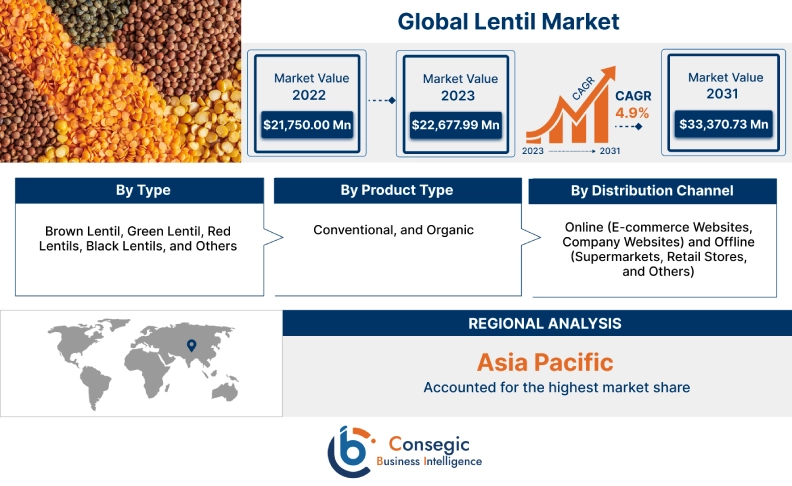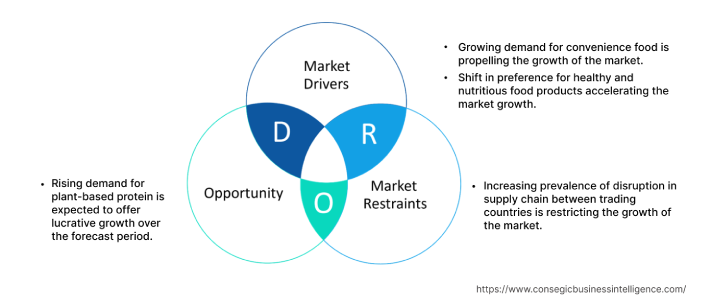Lentil Market Size :
Consegic Business Intelligence analyzes that the lentil market is growing with a CAGR of 4.9% during the forecast period (2023-2031), and the market is projected to be valued at USD 33,370.73 Million by 2031 and USD 22,677.99 Million in 2023 from USD 21,750.00 Million in 2022.
Lentil Market Scope & Overview:
Lentil is the oldest cultivated pulse which is mainly used for edible purposes. The name lentil is derived from the lens-shaped structure of the seed. As lentil belongs to the legume family, it has certain nutritional value. This legume is a rich source of protein, fiber, vitamin B, iron, folates, zinc, and potassium. Lentil is considered a popular staple food in various regions across the world. This legume is broadly utilized as a popular convenience food due to its ability to get cooked within an hour.
Furthermore, lentils contain several beneficial plant compounds known as phytochemicals, which protect human health from chronic diseases such as heart diseases and diabetes. The seeds of lentils are mainly used to prepare soups and stews. Lentil is an excellent alternative to meat, owing to its high protein content. In addition, lentil is also used in a variety of dishes and cuisines, attributed to their earthly flavour and rather delicate structure. However, lentils consumed in raw state don't provide adequate benefits as compared to cooked lentils. Hence, these types of legumes are most utilized after boiling in water.
Lentil Market Insights :
Lentil Market Dynamics - (DRO) :
Key Drivers :
Growing demand for convenience food is propelling the growth of the market
Lentil is considered as one of the popular convenience foods. The demand for convenience food has witnessed an upward surge, owing to the increasing number of working women across the globe. In addition, the busy and tight schedule of the working population is also influencing the growth of the lentil market. Lentils take less time to cook and do not have to be soaked before cooking, owing to their smaller size. The versatile and affordable characteristics of lentils make them a conveniently accessible form of high-quality protein.
Furthermore, the long shelf-life of this legume contributes to increasing consumer preference for lentils as a convenience food. The packaged lentil lasts for a longer duration compared to its counterpart. For instance, according to the data published by the Lentils Organization in 2023, packaged lentils last for up to 1 year and cooked lentils need to be used within 3 months, if frozen. Thus, the ability of this legume to offer an excellent option for convenience food is accelerating the demand of lentils and subsequently driving the market growth.
Shift in preference for healthy and nutritious food products accelerating the market growth
Lentils are considered as a prominent source of protein. Additionally, these legumes are a rich source of plant fiber, potassium, zinc, iron, and vitamin B. Lentils are predominantly used by health-conscious consumers in their day-to-day diet routine. As the preference of consumers is changing towards more healthier and nutritious food options, lentil is becoming increasingly popular staple food across the world. This versatile legume lowers the risk of heart disease by controlling cholesterol and blood pressure levels. Hence it is heavily consumed in comparison to other legumes such as beans, chickpeas, and peas.
Furthermore, the increasing prevalence of favorable government policies for healthy and nutritious food is driving the vigorous growth of the market across the globe. For instance, according to the report published by the World Health Organization (WHO) in January 2021, the WHO urges various governments across the world to promote healthy food in public settings such as schools, childcare centres, nursing homes and hospitals, to avoid 8 million deaths caused by unhealthy diets. Thus, this significantly increases the demand for lentils and augments the growth of lentil in the market across the globe.
Key Restraints :
Increasing prevalence of disruption in supply chain between trading countries is restricting the growth of the market
Lentil is a major trading product, which contributes to the phenomenal economic growth of the participating countries in the trade. The increasing instances of conflicts between countries with respect to politics, environment, policies, and security subsequently lead to obstacles in supply chain activities. Thus, resulting in restriction of trading activities and impacting the smooth supply of items beyond the national borders.
Moreover, the increased incidences of diplomatic tensions between countries lead to an indefinite scope for economic slowdown by affecting the business trade. For instance, according to the article published by the Council on Foreign Relations, an organization, on September 2023, India and Canada postponed their trade negotiations, after diplomatic tension arose over the killing of a Sikh separatist. As a result, the trade of lentils to India has slowed down, owing to Canada being one of the largest producers of lentils in the world. Thus, the aforementioned factors are affecting trading activities and restricting the growth of the lentil market across the globe.
Future Opportunities :
Rising demand for plant-based protein is expected to offer lucrative growth over the forecast period
Lentil is considered a reliable source of protein, and it is an excellent substitute for animal fat. Traditionally, meat is predominantly consumed as a source of protein. However, the growing shift in preference for plant-based protein alternatives is accelerating the demand for lentil in the market. The expanding applications of lentil to develop healthy and nutritious alternatives in the snack and flour industry is expected to drive market growth over the forecast period.
Furthermore, the high nutrition profile of lentil makes it a primary choice for plant-based protein alternatives to replace animal-based protein. For instance, according to the article published by Lentils Organization in 2023, the nutrition profile offered by ½ cup of lentil includes 12 grams of protein and 8 grams of fiber, which makes it an ideal substitute for animal based protein. In addition, most population limiting the consumption of meat is expected to drive the growth of plant based protein industry, further enhancing the scope for new product development opportunities in the lentil market.
Lentil Market Report Insights :
| Report Attributes | Report Details |
| Study Timeline | 2017-2031 |
| Market Size in 2031 | USD 33,370.73 Million |
| CAGR (2023-2031) | 4.9% |
| By Type | Brown Lentil, Green Lentil, Red Lentils, Black Lentils, and Others |
| By Product Type | Conventional, and Organic |
| By Distribution Channel | Online (E-commerce Websites, Company Websites) and Offline (Supermarkets, Retail Stores, and Others) |
| By Region | North America, Europe, Asia-Pacific, Latin America, and Middle East & Africa |
| Key Players | AgroChimInvest LLC, ADM, Indica Agri International Pvt. Ltd, Sevan, Agro Rost, Adascan Grain Corporation, Hodmedod's British Wholefoods, Three Farmers, Komalika Farmer Producer Company Ltd., Organic Products India, Baghel Agro Industries, and ALBERTA PULSE GROWERS |
Lentil Market Segmental Analysis :
By Type :
The type segment is categorized into brown lentil, green lentil, red lentil, black lentils, and others. In 2022, the brown lentil segment accounted for the highest market share of 37.70% in the lentil market and is also expected to grow at the fastest CAGR over the forecast period. Brown lentil is the most commonly cultivated variety of lentil, making it a popular choice among consumers. This lentil range in color from khaki brown to dark black and has a mild, earthly flavor. Brown lentils hold it shape while cooking and are considered an ideal choice to use in warm stews, soups, salads, and casseroles. In addition, these lentils are heavily used in fast food industry to prepare veggie burgers and vegetarian meatloaf.
Furthermore, the abundant availability of brown lentils throughout the distribution channels has contributed to its market growth. For instance, according to the data published by the Food and Agriculture Organization of the United Nations in 2023, any bag with the name tag of lentils without any descriptor in the market is most likely full of brown lentil, making it a commonly found lentil variety in the market. Thus, the high visibility and distribution of brown lentils is significantly driving the phenomenal growth of this segment.
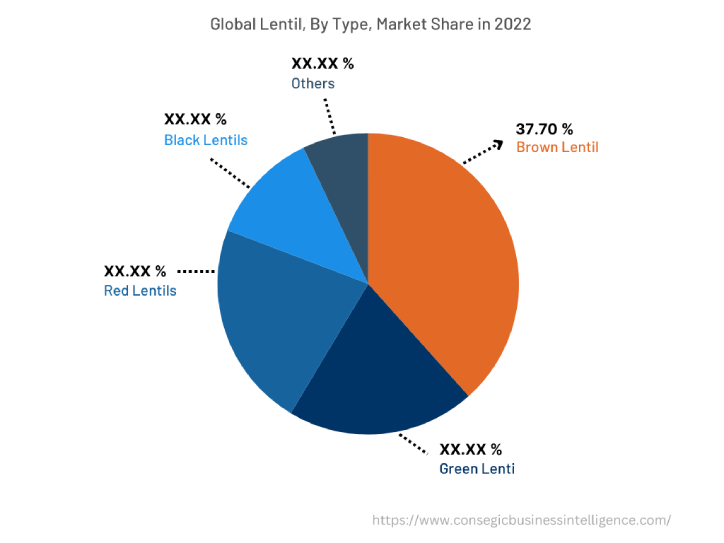
By Product Type :
The product type segment is conventional and organic. In 2022, the conventional segment accounted for the highest market share in the lentil market. Conventional lentils are cultivated by utilizing traditional farming methods. These methods are predominantly preferred by most farmers across the world. The ability of conventionally utilized farming methods to produce a high yield of lentil is one of the substantial factors driving the growth of the segment. Moreover, the affordable prices of conventional foods compared to organic food is another prominent factor influencing the segment growth.
Moreover, the organic segment is anticipated to grow at the fastest CAGR during the forecast period. The growth of this segment is mainly attributed to a rising preference for healthier alternatives to traditionally consumed products. The growing organic industry is expected to fuel exceptional growth of the segment. For instance, according to the Organic Industry Survey released by Organic Trade Association in May 2023, the organic food sales in United States reached revenue of USD 60 billion for the first time in 2022 and it is expected to grow at phenomenal growth in the upcoming years. Thus, the growing organic food industry is expected to surge the demand for organic lentils, further contributing to segment growth.
By Distribution Channel :
The distribution channel segment is bifurcated into online and offline. In 2022, the offline segment accounted for the highest market share in the lentil market. The offline segment is further categorized into supermarkets, retail stores, and others. The growth of this segment is attributed to factors such as more interactive purchases, immediate product availability, and easier return options. The offline distribution channel is a conventional method of distributing products to consumers. This channel is mainly preferred by customers, owing to its ability to provide risk-free service, thus promoting market growth.
Moreover, the online segment is anticipated to grow at the fastest CAGR during the forecast period. The online segment is further categorized into e-commerce websites and company websites. The growth of this segment is majorly attributed to various factors such as wider reach, lower overhead costs, and remote delivery. The rising use of buy now pay later services across the world is expected to drive the segment growth in upcoming years. For instance, according to the survey conducted by Federal Reserve Bank of New York, out of 1000 respondents, 64% were offered a BNPL option and 19% opted for BNPL. Thus, these advantages associated with the online payment system is another factor expected to drive the growth of the online segment over the forecast period.
By Region :
The regional segment includes North America, Europe, Asia Pacific, Middle East and Africa, and Latin America.
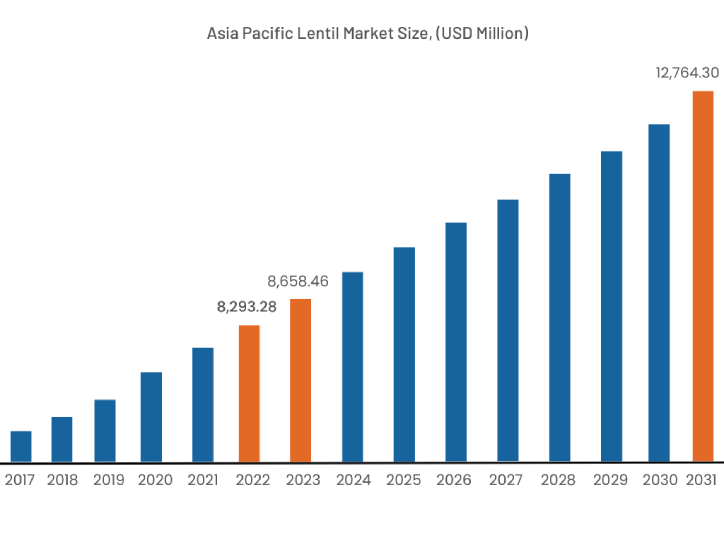
In 2022, Asia Pacific accounted for the highest market share of 45.13% valued at USD 8,658.46 Million in 2022 and USD 8,658.46 Million in 2023 and is expected to reach USD 12,764.30 Million in 2031. In the Asian Pacific region, India accounted for the highest market share of 35.50% in 2022. The growth of lentil market is mainly attributed to rising awareness among consumers about the health benefits of lentils. The expanding applications of lentils in the food and snack industry is another important factor contributing to the phenomenal growth. Additionally, the growing applications of lentil flour as an alternative to conventional wheat flour for preparing products such as bread and pasta is also influencing the growth of lentil market in Asian Pacific region.
However, North America is expected to grow at the fastest CAGR of 5.3% during the forecast period. The growth of this region is primarily attributed to the increased popularity of snacks made up of lentils. Additionally, the increasing lentil production across North American countries driving the growth of this region. For instance, according to the article published by the United States Department of Agriculture on September 2023, the production of lentil in United States grew by 50% during the last 10 years, expanding from 240,000 tons in 2011 to 376,000 tons in 2020.
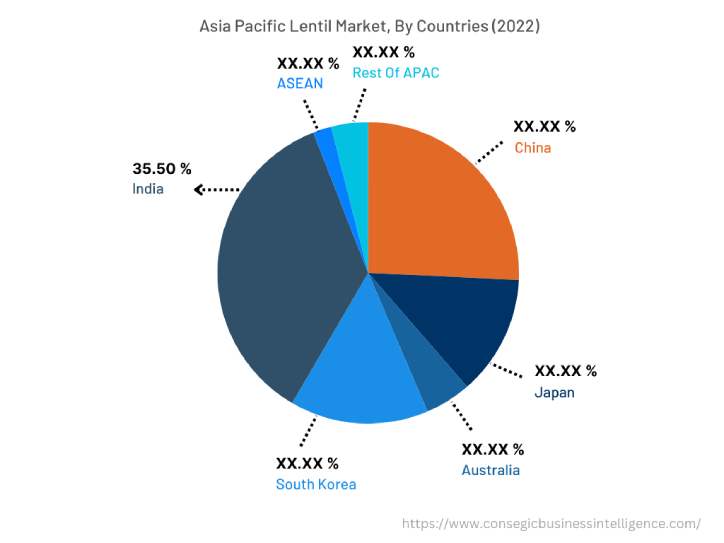
Top Key Players & Market Share Insights:
The lentil market is highly competitive, with several large players and numerous small and medium-sized enterprises. These companies have strong research and development capabilities and a strong presence in the market through their extensive product portfolios and distribution networks. The market is characterized by intense competition, with companies focusing on expanding their product offerings and increasing their market share through mergers, acquisitions, and partnerships. The key players in the market include-
- AgroChimInvest LLC
- ADM
- Organic Products India
- Lentiful
- Baghel Agro Industries
- ALBERTA PULSE GROWERS
- Indica Agri International Pvt. Ltd
- Sevan
- Agro Rost
- Adascan Grain Corporation
- Hodmedod's British Wholefoods
- Three Farmers
- Komalika Farmer Producer Company Ltd.
Recent Industry Developments :
- In October 2023, Three Farmers, a snack food maker derived from pulse crops like chickpeas, lentils and fava beans based out of Saskatoon, set up a new production facility of the company in the Saskatoon, Canada.
- In July 2021, AGT Foods opened its new Canadian USD 65 million grain terminal in Delisle, Saskatchewan, Canada. The facility will be able to clean a thousand tonnes of grain per hour for durum wheat, lentils, and peas.
Key Questions Answered in the Report
What was the market size of the lentil market in 2022? +
In 2022, the market size of lentil was USD 21,750.00 million.
What will be the potential market valuation for the lentil market by 2031? +
In 2031, the market size of lentil is expected to reach USD 33,370.73 million.
What are the key factors restricting the growth of the lentil market? +
Increasing prevalence of diplomatic tension between trading countries is restricting the growth of the market.
What is the dominant segment in the lentil market by type? +
In 2022, the brown lentil segment accounted for the highest market share of 37.70% in the overall lentil market.
Based on current market trends and future predictions, which geographical region will have the fastest impact on the lentil market's growth in the coming years? +
North America is expected to be the fastest-growing region in the market during the forecast period.
